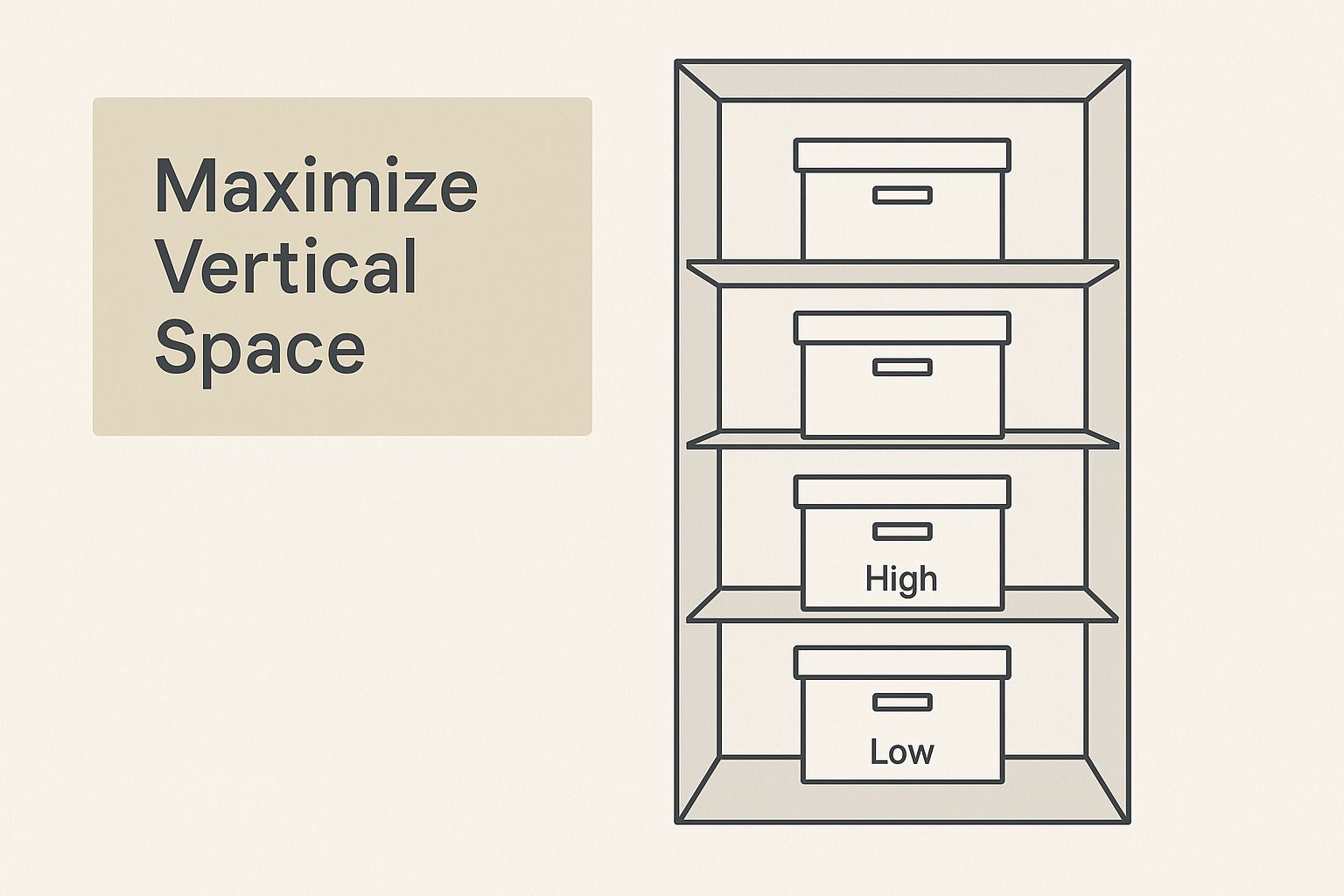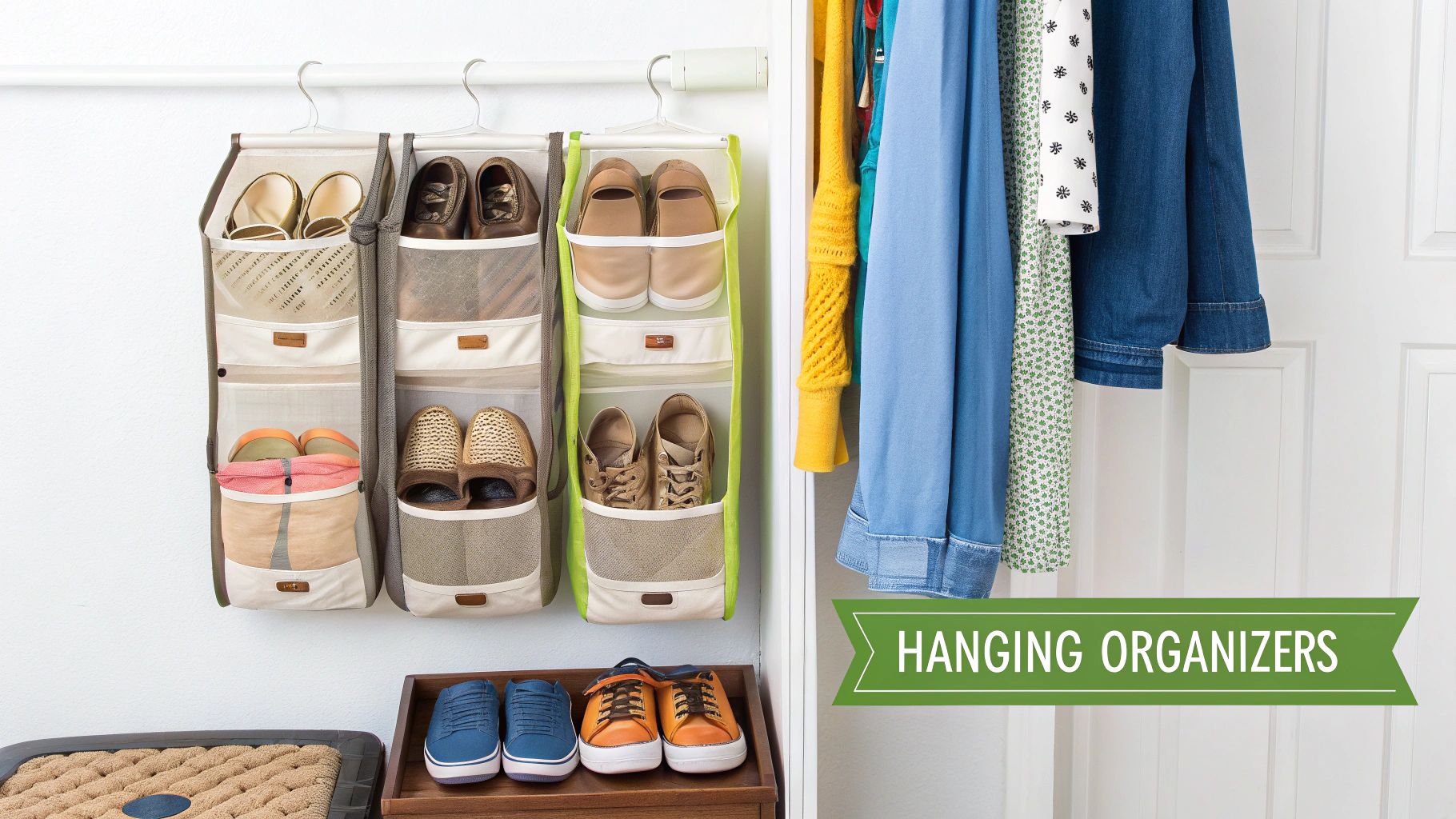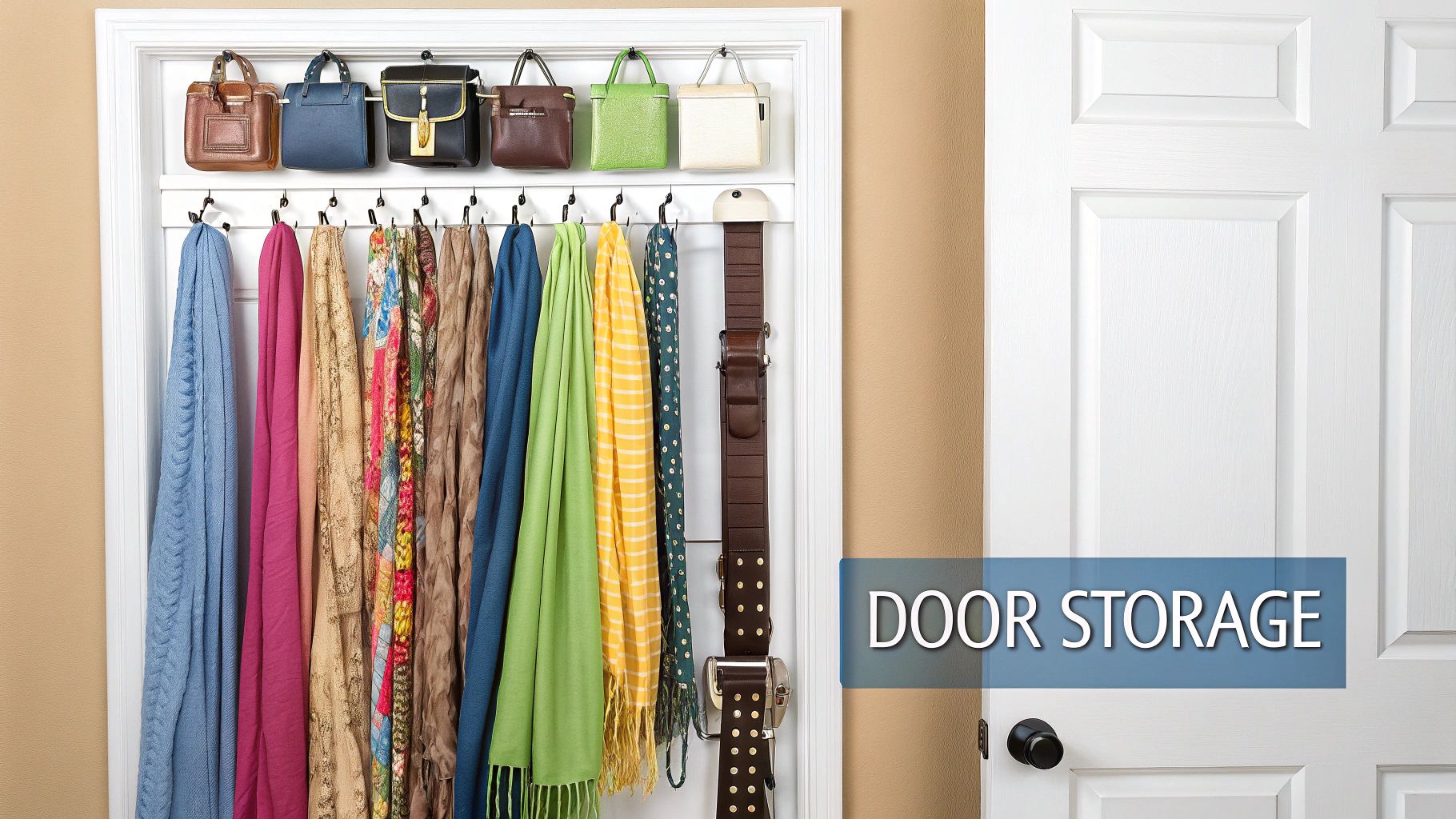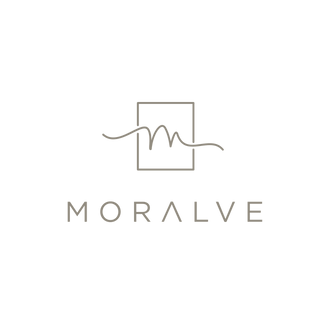Closet Organization Ideas to Transform Your Home

Let's be honest, staring into a messy closet is a terrible way to start the day. It’s a frustrating, time-sucking vortex that just adds stress to your morning. The best closet space saving ideas aren't about needing a bigger closet, but about organizing the one you have to work smarter.
Your Guide to an Organized, Clutter-Free Closet
A disorganized closet feels like a daily scavenger hunt, doesn't it? You know that perfect shirt is in there somewhere, but finding it is a whole other story. Most people blame the closet's size, but the real culprit is almost always a lack of effective organization.
Instead of just stuffing things in, think of your closet as your personal wardrobe command center. When it's organized well, getting ready is smooth and effortless, just like cooking in a kitchen where you know exactly where every spoon and spice is. The goal is to create a calm, functional space where every item has a dedicated home.
Core Principles of Closet Organization
To achieve a truly organized closet, we’ll walk through a few foundational ideas. Each concept builds on the last, giving you a solid framework to transform any closet, no matter its size. These are the secrets to building a system that lasts.
- Maximizing Vertical Real Estate: So much space goes to waste above and below your hanging rod. We’ll look at how to claim all that untapped potential.
- Selecting the Right Tools: The right organizers are the backbone of a good system. They can literally double your closet's capacity and keep items neat.
- Strategic Decluttering First: You can't organize clutter. The first, non-negotiable step is to edit your wardrobe. You need a clean slate to build your new system.
Once you get a handle on these principles, you can put practical solutions in place that actually stick. This is about more than just being tidy; it's about building a system that gives you back time and energy, one organized section at a time.
Maximizing Your Closet’s Vertical Space
Look at most closets, and you'll see a ton of wasted real estate. All that empty air between your clothes and the ceiling? That’s untapped organizational potential. Treating your closet like a single-story bungalow when it could be a multi-level condo is one of the biggest organizational mistakes people make.
By thinking vertically—stacking rods, adding shelves, and using the full height of the space—you can unlock new tiers of storage. It’s not uncommon to double or even triple your closet’s capacity this way.
This simple shift in perspective is the foundation for a truly organized closet.
Vertical Storage Concepts
One of the easiest upgrades you can make is adding a double-hang rod that clips right below your main clothing rail. Just like that, you’ve created a second level for your clothes, letting you hang shirts up top and pants or skirts below in the exact same footprint, creating instant organization.
Stackable shelving units are another game-changer. They can slide into those awkward, unused zones above shoeboxes or below hanging clothes. Look for adjustable ones so you can create dedicated tiers for bulky sweaters, seasonal items, or folded jeans. And don't forget the back of your door! An over-the-door organizer with pockets turns that wasted space into a perfect home for accessories like scarves, belts, and shoes, all without drilling a single hole.
Here are a few popular tools that put these concepts into action:
- Double-hang Rod: Instantly adds a second tier for hanging shorter items like shirts and folded pants.
- Stackable Shelving: Modular shelves that fit into unused vertical gaps to hold folded clothes and bins.
- Over-the-Door Organizer: Taps into the unused potential of your door panel to store accessories, freeing up valuable shelf and rod space.
- Pull-Down Wardrobe Lift: A handle-operated rod that brings high-up clothes down to you, making the top of your closet easily accessible.
It's no surprise that as homes get smaller, the market for closet organizers is booming. Valued at USD 7.64 billion, it's projected to hit USD 14.57 billion by 2032, growing at an impressive 8.4% CAGR. You can learn more about closet organizers market growth on Credence Research. People are investing heavily in solutions like adjustable shelves, pull-out racks, and tiered hangers to make every inch count.
To help you visualize how these different solutions stack up, here’s a quick comparison.
Comparing Vertical Storage Methods
This table breaks down some of the most effective vertical storage methods, showing what they’re best for and which solution might be right for your space.
| Storage Method | Best For | Space-Saving Impact | Example Solution |
|---|---|---|---|
| Double-hang Rod | Hanging garments | 50% more hanging space | The MORALVE 8-Pack Space-Saving Pant Hanger |
| Stackable Shelving | Folded clothes & bins | 30% better spacing | Adjustable Wire Shelf Units |
| Over-the-Door Organizer | Accessories & shoes | Frees up floor space | Multi-pocket Door Shoe Rack |
| Pull-Down Wardrobe Lift | Out-of-reach items | Improves accessibility | Drop-down Closet Lift |
Choosing the right combination of these tools is what ultimately transforms a cluttered closet into a functional one.
Planning a Multi-Level Layout
Ready to build your organized closet? Start by measuring the full height of your closet. This will help you map out where to place shelves or rods at logical intervals, ensuring each tier is both useful and accessible.
A great next step is to install that second rod at mid-height, perfect for shorter garments like skirts and blouses. This is where clever tools really shine. For instance, the MORALVE 8-Pack Space-Saving Pant Hanger maximizes that lower level by holding multiple pairs of pants in a single, cascading slot.
By combining rods, shelves, and door pockets, you actively convert dead air into practical, usable storage. These closet space saving ideas are all about creating organizational zones to multiply your capacity without needing to expand your closet's physical footprint.

As you can see, a well-planned vertical layout can unlock up to 60% more storage across the board—for garments, accessories, and even shoeboxes.
With these vertical strategies in mind, you can start choosing the right tools to bring your multi-level closet to life.
Choosing the Right Tools for the Job
Any seasoned organizer will tell you that the right tools can make or break your efforts. It’s like trying to cook a gourmet meal with a butter knife – you might get it done, but it won’t be pretty or efficient. The same principle applies to your closet; successful organization comes from picking the right organizers for your specific clothes and space.
Simply grabbing a bunch of random bins at the store is a recipe for more clutter. The smarter approach is to first figure out what your closet’s biggest organizational headaches are. Is it a jam-packed clothing rod? A jumble of shoes on the floor? Once you know the problem, you can find a tool designed to solve it, making sure every organizer you bring home actually works for you.
Start With Your Hangers
If you're looking for the single biggest bang-for-your-buck organizational change, look no further than your hangers. Those thick, clunky plastic or wooden hangers are closet bullies, taking up way more rod space than they need to with their bulky shoulders.
Making the switch to slim, non-slip velvet hangers can feel like you've magically doubled your closet space overnight. They’re designed to be incredibly thin but still sturdy, letting you hang more clothes without everything getting squished together. That velvety grip is a game-changer, too—no more finding your favorite silk blouse puddled on the floor. For a deeper dive, check out this complete guide to the best space saving hangers to see how different styles stack up.
Don't stop at standard hangers, though. A few specialized hangers can solve some of the most common organizational puzzles:
- Multi-Tier Pants Hangers: These are brilliant for hanging several pairs of pants or even skirts in the vertical space usually occupied by just one.
- Cascading Hanger Hooks: These simple but genius little hooks let you chain your hangers together, one below the other. They're perfect for putting outfits together or packing away off-season clothes.
- Rotating Racks: If your ties, belts, or scarves are in a tangled mess, a rotating rack gives you a neat, easy-to-see home for your whole collection in a tiny amount of space.
Tame the Small Stuff With Dividers
So, what do you do with everything that can't be hung up? Socks, underwear, scarves, and belts have a way of turning into a chaotic pile in any drawer or on any shelf they touch. This is exactly where drawer dividers come in to save the day.
Think of dividers as creating individual "homes" for all your small accessories. When everything has its own spot, you can find what you need in seconds and stop the dreaded "accessory avalanche" that happens when you're digging for one specific item.
Dividers essentially create a filing system for your foldable clothes and accessories. You can use honeycomb-style organizers to give each pair of socks or rolled-up underwear its own cell, or adjustable rectangular dividers for neatly folded t-shirts. The trick is to match the divider to the item. A shallow tray is perfect for sunglasses and watches, while deeper bins are better for chunky winter scarves. By containing the chaos, you create a much more organized and functional space.
The Art of Strategic Decluttering
You can't organize clutter. It’s a simple truth, but one we often ignore. Trying to arrange a closet overflowing with things you don't wear is like trying to paint on a dirty canvas—the masterpiece you’re hoping for just won’t happen.
So, before you rush out to buy a single new hanger or shelf, the real work begins with editing your wardrobe. This is hands-down one of the most powerful closet space saving ideas because it creates the foundation for an organizational system that actually works.
Think of it less as a chore and more as curating your personal collection. The point isn't just to toss things out, but to consciously decide what earns its place in your closet. When your space is cluttered, the good stuff—the clothes you actually love—gets buried, making the simple act of getting dressed a daily struggle. A clean slate makes every organizational tool you add 100% more effective.
Conducting a Simple Closet Audit
Forget those complicated, multi-week decluttering systems that feel like a second job. An effective closet clean-out boils down to asking a few honest questions. As you pick up each item, just take a moment to really think about its role in your life right now.
This simple approach helps you make smart decisions without getting sidetracked by "what-ifs" or nostalgia. If you want a more in-depth game plan, our guide on how to declutter your closet breaks it down step-by-step.
To get started, just ask yourself these four things:
- Would I buy this today? Seriously. If you saw it on the rack right now, would you pull out your wallet? This cuts right through the noise and tells you if it fits your current style.
- Does this fit my current lifestyle? That fantastic blazer is great, but if you've been working from home for two years, is it taking up valuable real estate?
- Have I worn this in the last year? Be ruthless here. Barring special occasion outfits, if it hasn’t seen the light of day in 12 months, it's probably just a freelooper in your closet.
- Is it comfortable and does it make me feel good? Life is way too short to wear clothes that pinch, sag, or make you feel anything less than great.

Sorting Your Items Effectively
Once you start asking those questions, the answers will naturally guide you to sort things into piles. Physically separating your clothes is crucial—it stops you from second-guessing and just shoving everything back where it was.
The goal is to make decisive choices. By establishing clear categories for your clothes, you create an organized exit strategy for every item that no longer serves you, making the entire process feel manageable and productive.
Before you pull the first hanger, set up three distinct zones or boxes:
- Keep: These are the winners. You love them, you wear them, and they fit who you are today. They get to go back into the closet.
- Donate/Sell: Good-quality items that just aren't for you anymore. They can have a second life with someone else.
- Toss: This is for anything stained, ripped, or just too worn out to be passed along.
By tackling the clutter first, you do more than just make space. You’re curating a wardrobe that’s a true reflection of you, making it infinitely easier to organize.
Solutions for Awkward and Small Closets
Let's be honest, not all closets are created equal. Many of us are stuck with spaces that are frustratingly small, awkwardly shaped, or so deep that things seem to vanish into a black hole at the back. These challenging closets need more than just standard organizers; they demand creative closet space saving ideas that can adapt to their unique quirks.
Instead of seeing these limitations as a dead end, think of them as an organizational puzzle. With the right strategy, even the most difficult closet can go from a source of daily frustration to a surprisingly efficient storage space. The trick is finding solutions flexible enough to work around non-standard dimensions.

Conquering Difficult Dimensions
When your closet has strange angles or deep, unreachable corners, standard, one-size-fits-all shelving just won't cut it. You need tools that can bring the storage to you. This is where modular and adaptable solutions really prove their worth, turning unusable areas into prime real estate.
The core principle for awkward closets is accessibility. If you can't easily see and reach what you own, you won't use it. Pull-out and adjustable systems are designed to conquer this exact problem, making every inch of your closet functional.
Here are a few practical fixes for common organizational headaches:
- For Deep Closets: Install pull-out shelves or wire drawers. They essentially act like extendable trays, letting you access items stored way in the back without having to dig through everything in front.
- For Narrow Closets: Use tension rods to add another hanging tier between two walls. It's the perfect spot for shorter items like skirts or kids' clothes, instantly doubling your hanging space without any drilling.
- For Unused Wall Space: Mount a pegboard on an empty wall. With a few hooks and small shelves, it becomes a completely customizable home for jewelry, belts, hats, and scarves.
These kinds of solutions are more important than ever as our living spaces get smaller. The global market for reach-in closets was valued at USD 2.8 billion and is projected to hit USD 4.7 billion by 2033. This growth is a direct result of the increasing need for smart storage in smaller homes. You can learn more about the demand for reach-in closets from DataHorizzon Research.
Making Every Nook and Cranny Count
Even after you’ve organized the main area, there are often small, overlooked spots that can offer up bonus storage. That sliver of wall next to the door? The floor space under your shirts? The back of the door itself? These are all hidden organizational opportunities.
This is where you can get really creative with smaller, targeted organizers. A slim, rolling cart, for example, can slide perfectly under hanging shirts to create a mobile "drawer" for shoes or folded sweaters. For more targeted advice, check out our guide on how to organize shoes in a closet.
The ultimate goal is to piece together a system that feels custom-built for your unique space, ensuring no inch goes to waste. By combining these smart, adaptable tools, you can finally win the battle against your awkward closet.
Putting It All Together: Your Custom Closet System
Alright, we've covered a ton of organizational concepts. Now comes the fun part: pulling these ideas together to create a system that works perfectly for you. A truly effective closet isn't a pre-packaged solution; it's a personalized setup that fits your wardrobe, your habits, and your daily life like a glove.
Think of it like building with LEGOs. You've got all the essential bricks—the vertical hangers, the drawer dividers, the shoe organizers. Now you get to assemble them in a way that makes sense for what you actually own. Someone with a massive sneaker collection will build a very different closet than someone who lives in business suits. The goal is to mix and match these strategies to design a space that feels completely intuitive.
Designing Your Game Plan
First things first: take a good, hard look at everything left after your big declutter. Having a clear inventory of what you need to store is the foundation of your organizational design. Are you drowning in dresses that need hanging space, or is your sweater collection threatening a hostile takeover of your shelves?
Your lifestyle dictates the layout. Here are a few examples of how to tailor your space:
- For the Office Professional: You need easy access to crisp shirts, blazers, and trousers. Make hanging space the star of the show, and use multi-tier hangers to keep all your work pants together without hogging precious rod space.
- For the Fitness Enthusiast: Grab-and-go is the name of the game. Use drawer dividers to separate leggings from tops, and pop open-front bins on a shelf for quick access to gear.
- For the Fashion Collector: Your closet is part storage, part gallery. Combine specialized shoe racks with dedicated shelving for handbags to create a functional display that keeps your prized possessions safe and visible.
The best closet organization system is one you don't even have to think about. It should naturally support your lifestyle, not force you to change your habits. When your closet stays tidy with almost no effort, you know you've succeeded.
This is exactly why the custom closets market is booming. Valued at USD 6.5 billion globally, it’s projected to nearly double to USD 12.2 billion by 2033. People are tired of one-size-fits-all solutions. You can discover more insights about the custom closets market on Verified Market Reports to see just how big the demand for tailored storage has become.
Got Questions? We've Got Answers
Even the best-laid plans can hit a snag. As you start putting these closet organization ideas into practice, you're bound to have a few questions. Let's tackle some of the most common ones that pop up during a closet makeover.
Think of this as your go-to guide for those last-minute details. Getting these things right is what keeps your closet looking great long after the initial overhaul is done.
How Often Should I Declutter My Closet?
For a deep clean, aim for at least twice a year. The change of seasons, especially spring and fall, is the perfect time for this. As you're swapping your sweaters for t-shirts, you're already handling every piece of clothing, making it the most natural time to pull out things you didn't wear.
For day-to-day maintenance, you can't beat the "one-in, one-out" rule. It's simple: every time a new shirt, pair of pants, or dress comes into the closet, an old one has to go. This one habit is a game-changer for preventing that slow creep of clutter.
What Is the Best Way to Organize Shoes?
This really comes down to your collection and the space you're working with. If you've got some vertical space to play with, clear, stackable shoe boxes are fantastic. They keep your shoes dust-free and you can see exactly what's inside without having to unstack a tower of boxes just to find your favorite sneakers.
Another one of the best closet space saving ideas, especially for tight spaces, is an over-the-door shoe organizer. It's a classic for a reason. You can neatly store a dozen pairs of shoes using nothing but the back of your door, which frees up precious floor and shelf space.
Keeping shoes off the floor is a non-negotiable for an organized closet. It instantly makes the space look tidier and frees up that prime real estate for bigger things like laundry hampers or storage bins.
Are Custom Closet Systems Worth the Investment?
A fully custom closet is a beautiful thing, but let's be honest, it's a huge investment. The good news? You can get 90% of the benefit for a tiny fraction of the cost by taking a modular, DIY approach.
By strategically using smart tools like multi-level hangers, drawer dividers, and stackable shelf units, you can build a system that feels custom-made for your wardrobe. It’s a much smarter, more flexible way to get that high-end organization without the high-end price tag.
Ready to create a closet that feels bigger and works better? It all starts with having the right tools. Explore the collection at MORALVE to discover expertly designed space-saving hangers that will turn your closet into a perfectly organized, stress-free zone. Visit MORALVE to get started today.


Leave a comment